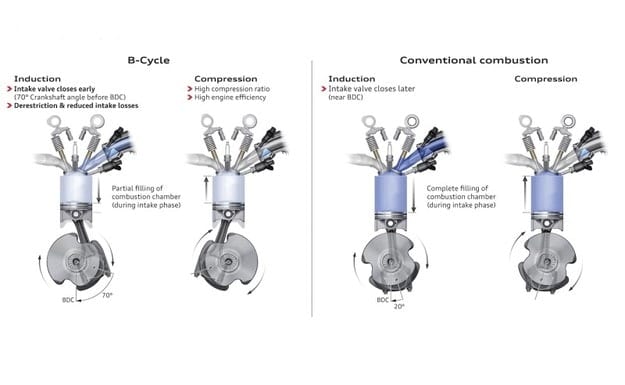
Atkinson, Miller, B-cycle process: what it really means
Content
VTG turbochargers in VW engines are actually modified diesel engines.
Atkinson and Miller cycles are always associated with increased efficiency, but there is often no difference between them. Perhaps it doesn't make sense, because both changes come down to a fundamental philosophy - creating different compression and expansion ratios in a four-stroke gasoline engine. Since these parameters are geometrically identical in a conventional engine, the gasoline unit suffers from the danger of fuel knocking, requiring a reduction in the compression ratio. However, if a higher expansion ratio could be achieved by any means, this would result in a higher level of "squeezing out" the energy of the expanding gases and would increase the efficiency of the engine. It is interesting to note that, purely historically, neither James Atkinson nor Ralph Miller created their concepts in search of efficiency. In 1887, Atkinson also developed a patented complex crank mechanism consisting of several elements (similarities can be found today in the Infiniti VC Turbo engine), which was intended to avoid Otto's patents. The result of complex kinematics is the implementation of a four-stroke cycle during one revolution of the engine and another piston stroke during compression and expansion. Many decades later, this process will be carried out by keeping the intake valve open for a longer period of time and almost without exception used in engines in combination with conventional hybrid powertrains (without the possibility of external electrical charging), such as those of Toyota and Honda. At medium to high speeds this is not a problem because the intrusion flow has inertia and as the piston moves backward it compensates for the return air. However, at low speeds, this leads to unstable engine operation, and therefore such units are combined with hybrid systems or do not use the Atkinson cycle in these modes. For this reason, naturally aspirated and intake valves are conventionally considered the Atkinson cycle. However, this is not entirely correct, because the idea of realizing various degrees of compression and expansion by controlling the valve opening phases belongs to Ralph Miller and was patented in 1956. However, his idea is not aimed at achieving greater efficiency, and lowering the compression ratio and the corresponding use of low-octane fuels in aircraft engines. Miller designs systems to close the intake valve earlier (Early Intake Valve Closure, EIVC) or later (Late Intake Valve Closure, LIVC), as well as to compensate for the lack of air or to keep the air returning to the intake manifold, compressor is used.
It is interesting to note that the first such asymmetric-phase engine running on a later one, defined as the "Miller cycle process", was created by Mercedes engineers and has been used in the 12-cylinder compressor engine of the W 163 sports car since 1939. before Ralph Miller patented his test.
The first production model to use the Miller cycle was the 6 Mazda Millenia KJ-ZEM V1994. The inlet valve closes later, returning part of the air to the intake manifolds with a degree of compression is practically reduced, and a mechanical compressor Lysholm is used to hold the air. Thus, the expansion ratio is 15 percent greater than the compression ratio. Losses caused by compression of air from the piston to the compressor are offset by improved final engine efficiency.
Strategies with very late and very early closures have different advantages in different modes. At low loads, a later closing has the advantage of providing a wider open throttle and maintaining better turbulence. As the load increases, the advantage shifts toward an earlier close. However, the latter becomes less effective at high speeds due to insufficient filling time and a large pressure drop before and after the valve.
Audi and Volkswagen, Mazda and Toyota
Currently, similar processes are used by Audi and Volkswagen in their 2.0 TFSI (EA 888 Gen 3b) and 1.5 TSI (EA 211 Evo) devices, which were recently joined by the new 1.0 TSI. However, they use a pre-closing inlet valve technology in which the expanding air is cooled after the valve closes earlier. Audi and VW call the process the B-cycle after the company's engineer Ralph Budak, who refined Ralph Miller's ideas and applied them to turbocharged engines. With a compression ratio of 13: 1, the actual ratio is about 11,7: 1, which in itself is extremely high for a positive ignition engine. The main role in all this is played by the complex valve opening mechanism with variable phases and stroke, which promotes vortex and adjusts depending on the conditions. In B-cycle engines, the injection pressure is increased to 250 bar. Microcontrollers control a smooth process of phase change and transition from B-process to normal Otto cycle under high load. In addition, the 1,5- and 1-liter engines use quick-response variable geometry turbochargers. Cooled pre-compressed air provides better temperature conditions than direct strong compression in a cylinder. Unlike Porsche's high-tech BorgWarner VTG turbochargers used for more powerful models, VW's variable geometry units created by the same company are practically slightly modified turbines for diesel engines. This is possible due to the fact that, due to everything described so far, the maximum gas temperature does not exceed 880 degrees, that is, slightly higher than that of a diesel engine, which is an indicator of high efficiency.
Japanese companies confuse the standardization of terminology even more. Unlike other Mazda Skyactiv gasoline engines, the Skyactiv G 2.5 T is turbocharged and operates over a wide range of loads and rpm in the Miller cycle, but Mazda also induces a cycle in which their naturally aspirated Skyactiv G units operate. Toyota uses a 1.2 D4-T ( 8NR-FTS) and 2.0 D4-T (8AR-FTS) in their turbo engines, but Mazda, on the other hand, defines them as the same for all of its naturally aspirated engines for hybrid and new generation Dynamic Force models. with atmospheric filling as "work on the Atkinson cycle". In all cases, the technical philosophy is the same.

